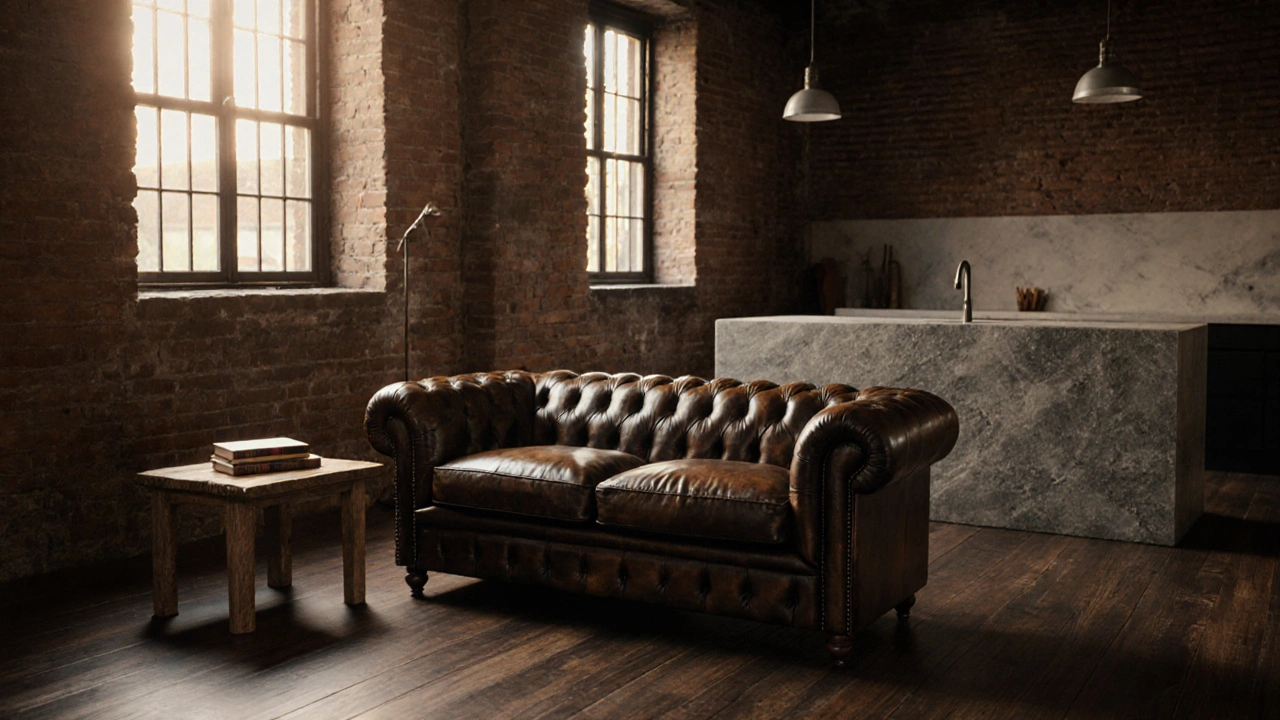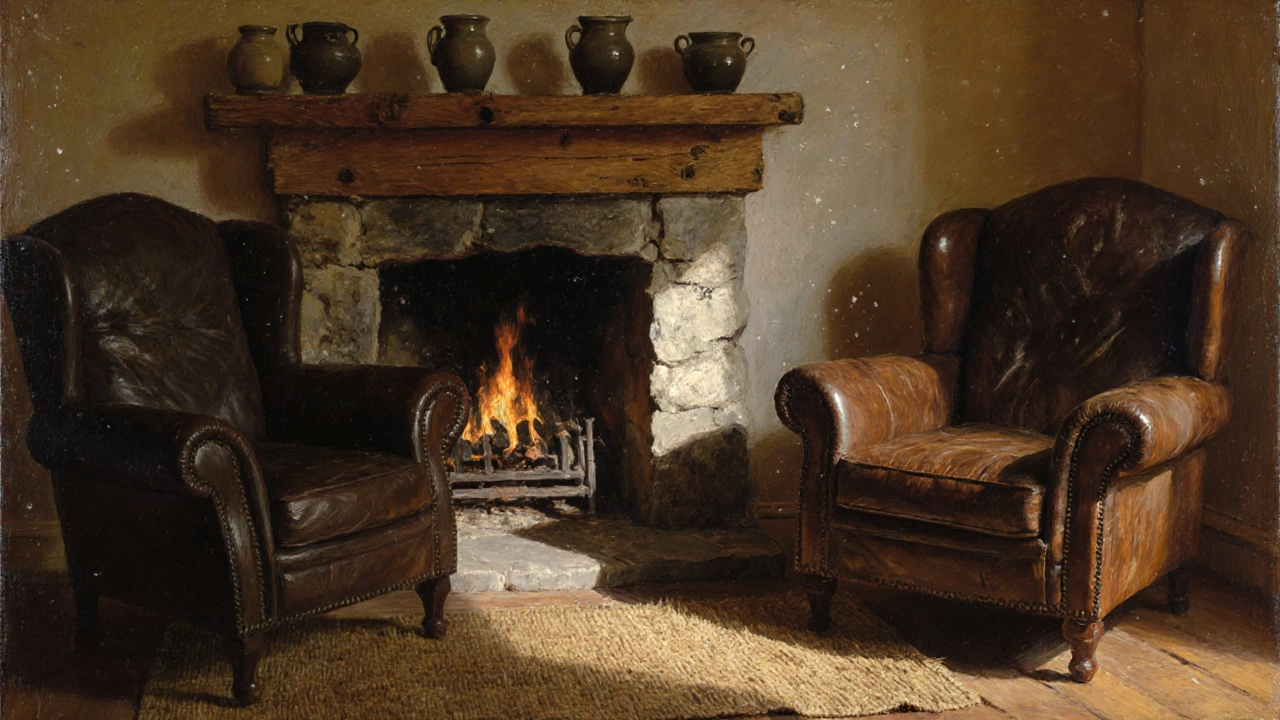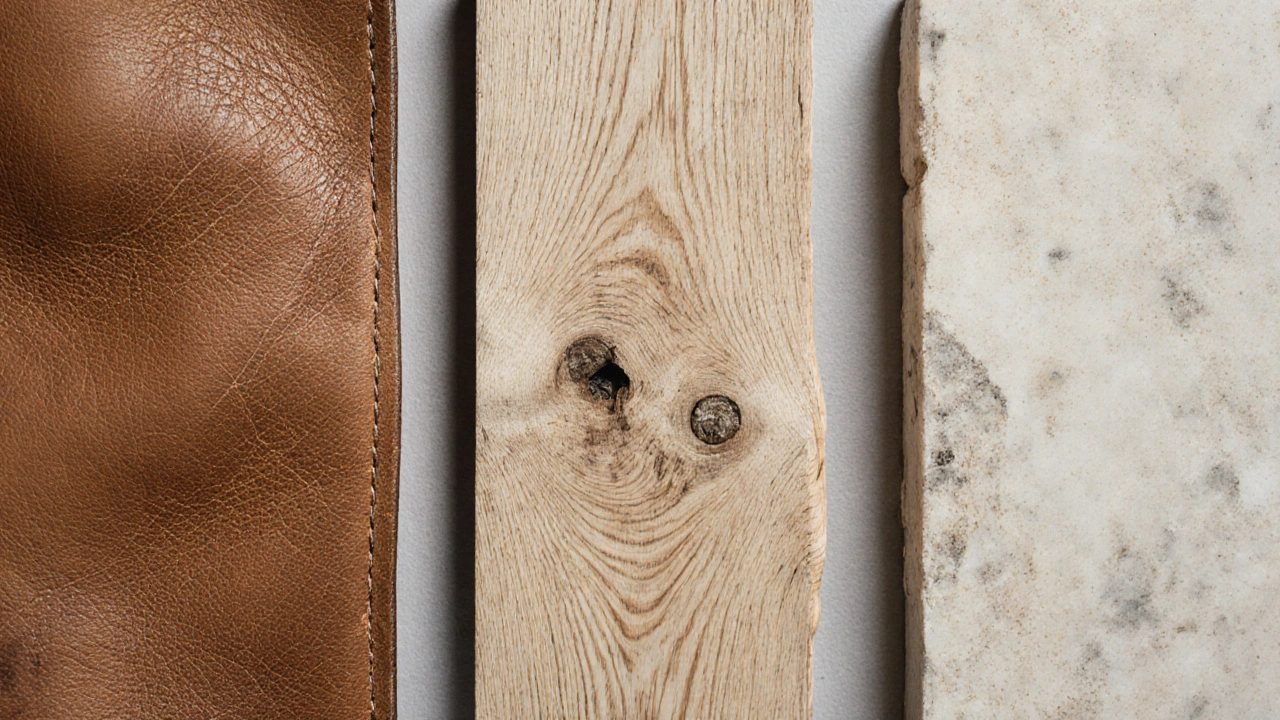
There’s something calming about walking into a room where the walls breathe, the floor feels warm underfoot, and the sofa invites you to sink in-not because it’s plush, but because it’s real. Natural materials like leather, wood, and stone aren’t just trends; they’re timeless. They’ve been used for centuries, not because they were fashionable, but because they work. They age gracefully, tell stories, and connect us to the earth in a way synthetic materials never can.
Why Natural Materials Feel Different
Think about the last time you touched a piece of mass-produced furniture. Maybe it was plastic-coated MDF or vinyl-wrapped particleboard. It felt cold. Lifeless. Now think about running your hand over a solid oak table, or the slight give of full-grain leather on a well-worn armchair. That difference isn’t just sensory-it’s psychological. Studies in environmental psychology show that natural materials reduce stress levels and improve focus. Not because they’re expensive, but because they’re authentic.
Leather, for example, isn’t just a surface. It’s a living material. It darkens with sunlight, softens with use, and develops a patina that’s unique to you. A sofa from 2018 doesn’t look worn out after seven years-it looks lived-in. That’s not a flaw. It’s character.
Leather: More Than Just a Couch
Not all leather is the same. You’ve got full-grain, top-grain, corrected-grain, and bonded leather. Only full-grain leather keeps the original surface intact. That means every scar, insect bite, and vein from the animal’s life stays visible. It’s not a defect-it’s proof it’s real. Full-grain leather lasts decades. Bonded leather? It peels after a couple of years.
Real leather needs care, but not much. A damp cloth every few months. A natural conditioner once a year. Avoid harsh chemicals. Sunlight fades it, but that’s part of the charm. A leather armchair by a window in Manchester? It’ll turn from honey to deep amber over time. That’s not fading. That’s evolving.
Leather isn’t just for sofas. Try leather drawer pulls on a walnut cabinet. Leather-wrapped lamp bases. Even leather-backed books on a shelf. It adds warmth without shouting.
Wood: The Foundation of Warmth
Wood is the most versatile natural material in interior design. It’s in the floor, the beams, the shelves, the cutting board. But not all wood is created equal. Engineered wood looks like oak but is layered plywood with a thin veneer. Solid wood? It’s one piece. It can be sanded down and refinished. Engineered wood can’t.
Popular choices today? White oak for its clean lines, walnut for its rich chocolate tones, and reclaimed teak for its rugged history. Reclaimed wood isn’t just eco-friendly-it’s got soul. A floor made from old barn beams carries the marks of nails, saw cuts, and decades of weather. That’s not a flaw. That’s a record.
When choosing wood for flooring, consider the grain direction and finish. A matte oil finish shows every scratch but deepens in color over time. A high-gloss polyurethane finish hides scratches but looks plastic after a few years. Go matte. Go natural. Let the wood age with you.
Don’t forget the small stuff. Wooden spoons in a kitchen drawer. A hand-carved wooden bowl on the coffee table. Even a simple wooden clock on the wall. These aren’t decorations. They’re anchors.

Stone: Cool, Solid, and Enduring
Stone is the quiet heavyweight of natural materials. It doesn’t need to be flashy to command attention. A slab of honed limestone on a kitchen island? It feels cool to the touch, even in summer. A fireplace built from local sandstone? It absorbs heat and radiates it slowly, all night.
Marble gets all the attention, but it’s high-maintenance. It stains easily, etches with lemon juice, and needs sealing every year. Limestone, slate, and soapstone are better choices for everyday use. Soapstone, for example, darkens over time and becomes more resistant to stains. It’s used in labs and kitchens because it’s durable and inert.
Stone doesn’t have to be expensive. Salvaged flagstones from old English courtyards can be repurposed as flooring. River rocks stacked as a backsplash? That’s texture without the price tag of imported marble.
Stone also works outdoors. A stone bench in a garden nook. A stone-edged fire pit. Even stone tiles in a mudroom. It’s the material that outlives trends. It doesn’t go out of style. It just gets better.
How to Mix Them Without Clutter
Using all three-leather, wood, and stone-in one room sounds risky. Too many textures can feel chaotic. But done right, they balance each other.
Start with one dominant material. Let’s say your floor is dark walnut. That’s your base. Then pick one accent. A limestone fireplace wall. Then add leather: a deep brown sofa with visible stitching. Now you’ve got three textures, but they’re layered, not piled.
Color harmony matters. Light wood (like ash or birch) pairs with cool stone (like slate or white limestone). Dark wood (walnut, ebony) works with warm stone (sandstone, travertine). Leather should match the undertones of the wood-warm leather with warm wood, cool leather with cool stone.
Keep metal finishes simple. Brushed brass or oil-rubbed bronze. Avoid chrome. It clashes with natural textures. Let the materials speak for themselves.
Real Homes, Real Results
In a converted Manchester warehouse, a couple replaced their glossy laminate floors with reclaimed oak planks. They kept the original brick walls but added a soapstone kitchen island. Their sofa? A deep brown, full-grain leather Chesterfield from a local artisan. Five years later, the floor has scuffs, the stone has a faint sheen from daily use, and the leather has a rich, even patina. No one asked them to redecorate. They didn’t want to. The space felt like home-not because it was perfect, but because it was real.
Another example: a small cottage in the Peak District. The owner used local limestone for the hearth and chimney. The shelves? Hand-hewn pine from a nearby sawmill. The chairs? Worn leather with visible stitching. No wallpaper. No plastic plants. Just wood, stone, and leather. Visitors say it feels like stepping into a story.

What to Avoid
Don’t fake it. Vinyl that looks like wood? It’s obvious. Laminate countertops pretending to be granite? They chip and look cheap after a year. Fake leather? It cracks. You can tell the difference when you touch it.
Don’t overdo it. One stone wall. One wood ceiling. One leather sofa. That’s enough. Too many natural materials in one space feels like a lumberyard.
Don’t ignore maintenance. Natural materials aren’t maintenance-free. They’re maintenance-aware. You clean leather. You oil wood. You seal stone. It’s not a chore-it’s a ritual. A way to stay connected to what you live with.
Where to Start
If you’re new to natural materials, start small. Swap out plastic picture frames for wooden ones. Replace a synthetic rug with a wool or jute one. Buy a single leather-bound notebook. Then a wooden cutting board. Then a stone soap dish.
Visit local makers. Look for reclaimed wood suppliers. Check out secondhand shops for vintage leather chairs. Stone tiles can be found at architectural salvage yards. You don’t need to buy new to get authentic.
It’s not about spending more. It’s about choosing better. One well-made leather chair lasts 20 years. Ten cheap ones? They end up in a landfill after five.
Why This Isn’t Just a Trend
Interior trends come and go. Neon accent walls. Metallic finishes. Overly curated boho. Natural materials? They’re not going anywhere. They’re not trendy. They’re traditional. They’re honest. They don’t pretend to be something they’re not.
In a world of screens, algorithms, and fast furniture, people are craving texture. They want to feel something real. Leather that warms to your body. Wood that smells like rain after a storm. Stone that stays cool in summer heat. These aren’t luxury features. They’re basic human needs.
You don’t need a million-dollar renovation. You just need to start noticing what’s around you. The grain in your table. The way light hits the leather armrest. The coolness of the stone under your bare feet in the morning.
That’s not design. That’s living.
Is leather really worth the investment for home furniture?
Yes-if you choose full-grain leather. It’s more expensive upfront, but it lasts 20 to 30 years with basic care. Cheaper leathers like bonded or top-grain start peeling after 3-5 years. Full-grain leather gets better with age, developing a unique patina that no synthetic material can replicate. It’s not just furniture-it’s a family heirloom in the making.
What’s the best wood for flooring in high-traffic areas?
White oak is the top choice. It’s hard, stable, and resists dents better than softer woods like pine. It also takes stains well, so you can go light or dark depending on your style. Reclaimed white oak adds character and sustainability. Avoid engineered wood in high-traffic zones-it can’t be sanded more than once or twice.
Are stone countertops practical for kitchens?
Yes, if you pick the right stone. Soapstone and limestone are excellent for kitchens-they’re non-porous, heat-resistant, and don’t stain easily. Marble is beautiful but requires sealing every 6-12 months and can etch from acidic foods. Granite is durable but often has a polished, artificial look. For real longevity and low upkeep, go with soapstone or honed limestone.
Can I mix different wood tones in one room?
Absolutely. The key is to keep the undertones consistent. Warm woods (walnut, cherry, teak) mix well together. Cool woods (oak, ash, birch) pair nicely too. Avoid mixing warm and cool tones unless you’re going for a deliberate contrast. Always have one dominant wood-the floor, for example-and use others as accents. That creates harmony, not chaos.
How do I care for natural materials without spending a fortune?
You don’t need fancy products. For wood, use a damp cloth and occasional beeswax polish. For leather, wipe with a slightly damp microfiber cloth and apply a natural conditioner like lanolin once a year. For stone, use pH-neutral cleaners-no vinegar or bleach. Seal stone surfaces every 1-2 years with a breathable sealer. Most of these products cost under £20 and last years. The real cost? Time. But that’s part of the connection.